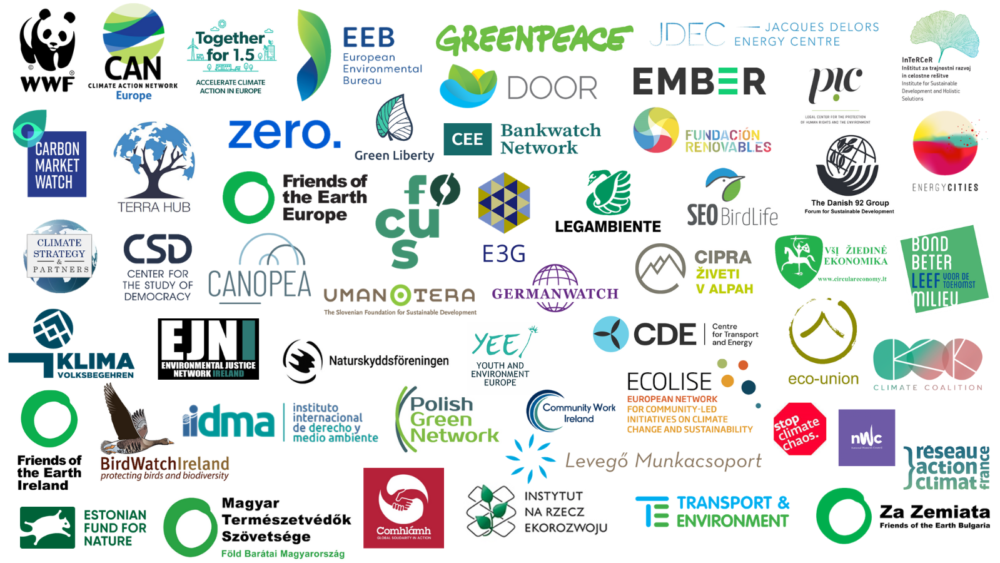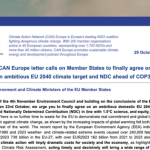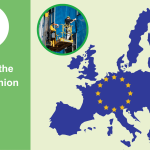The undersigned organisations are writing to you to express their serious concerns regarding the lacking ambition level and inadequate quality of the draft National Energy and Climate Plans (NECPs).
The window for stopping runaway climate change is closing rapidly, the loss of ecosystems and biodiversity continues apace, and our citizens face a cost of living crisis driven by fossil fuel price increases. Against this background, the revision of Member States’ National Energy and Climate Plans (NECPs) is of paramount importance. The plans need to be the key strategic planning tools to guide decarbonisation efforts at the national level in line with the 1.5°C target of the Paris Agreement, to reduce dependence on fossil fuels, to ensure early and granular planning, and ensure a rapid and fair transition to the clean economy of the future.
The current draft NECPs are dramatically unfit for purpose and need to be stronger, more comprehensive, and built on robust data and genuinely participative processes, otherwise we risk missing the mark on the EU climate and energy targets.
We undersigned organisations ask You to act as guardian of EU law and EU climate and energy obligations, and to issue recommendations to Member States with the emphasis and specificity needed to ensure that the NECPs are fit for purpose and can effectively guide the implementation of the EU Green Deal and the Fit for 55 package till 2030.
Our assessment of the draft updated NECPs portrays a very bleak picture.
- The process of updating the NECPs is extremely concerning so far, with more than 10 Member States (bigger countries among them: France, Germany, Poland, Romania) missing the submission deadline (only 15 Member States having submitted their draft plans as of 30 September 2023). The involvement of public and stakeholders in the drafting process has been inadequate, ranging from poor to non-existent.
- The overall level of climate ambition resulting from the submitted plans is insufficient not only to align with a 1.5°C compatible trajectory, but also to meet the EU 2030 climate targets. Several Member States are not in line with the unambitious minimum requirements set in the Effort Sharing Regulation.
- The energy dimension also provides reasons for concern. The phaseout of fossil fuels, which should already be well underway, is lagging behind: gas infrastructure is set to expand in several Member States, and a few plans even delay the phaseout of coal compared to the 2019 NECPs. The ambition level on energy savings is also too low. 20% energy savings are needed to align with the Paris Agreement. Many plans fail to provide contributions aligning with the new EU 2030 energy efficiency target as a minimum.
In the Commission’s assessment of the draft NECPs particular attention and scrutiny needs to be applied to the following criteria:
- 2030 national climate targets must be consistent with the 1.5°C limit of the Paris Agreement
- Consistency with the long-term trajectory, taking into account the Paris Agreement requirements on equity
- Include ambitious 2030 national energy contributions
- Include credible, consistent set of policies and measures
- Be based on robust and transparent assessments of supply and demand for key resources (such as water, land, biomass, renewable hydrogen) and on environmental impacts and constraints
- Ensure a fair and just transformation, among others through robust energy poverty alleviation targets and measures
- Adequate funding for the transition
- A collective, transparent process of formulating the plans
Finally, considering that the NECPs reflect the distinctive characteristics of each member state’s energy and climate policies, our organisations urge the Commission to engage in direct dialogue with national organisations, before formulating comments on the draft updates of these plans. This is especially crucial due to the lack of effective and efficient participation mechanisms at the national level.

Signatories:
Climate Action Network (CAN) Europe
Bond Beter Leefmilieu
Fundacja Instytut na rzecz Ekorozwoju/Institute for Sustainable Development Foundation (Poland)
Alliance of Associations Polish Green Network
ECOLISE –European Network for Community-Led Initiatives on Climate Change and Sustainability
Estonian Fund for Nature
Environmental Association “Za Zemiata” – Friends of the Earth Bulgaria
LEGAMBIENTE
Center for the Study of Democracy (Bulgaria)
Clean Air Action Group (Hungary)
Eco-union (Spain)
Environmental Justice Network Ireland (Ireland)
Friends of the Earth (Ireland)
Fundación Renovables (Spain)
Klimavolksbegehren (Austria)
NSC-Friends of the Earth Hungary
Transport&Environment
Centre for Transport and Energy (CZ)Climate Strategy
Naturskyddsföreningen – Swedish Society for Nature Conservation
Society for Sustainable Development Design (DOOR), Croatia Youth and Environment Europe (YEE)
Focus, Association for Sustainable Development
Umanotera, The Slovenian Foundation for Sustainable Development
Green Liberty (Latvia)
CIPRA Slovenia – national representative of CIPRA, the International Commission for the Protection of the Alps
ZERO – Association for the Sustainability of the Earth System (PT)
Jacques Delors Energy Centre (JDEC)
European Environmental Bureau
PIC – Legal Center for the Protection of Human Rights and the Environment, Slovenia
Energy Cities (ENC)
Friends of the Earth Europe
Greenpeace European unit
CEE Bankwatch Network
Terra Hub Croatia
InTeRCeR – Institute for sustainable development and holistic solutions
BirdWatch Ireland
Comhlámh – Irish Association of Development Workers and Volunteers
E3G
WWF European Policy Office
Réseau Action Climat-France (RAC-France)
Carbon Market Watch
Canopea
Community Work Ireland
National Women’s Council (Ireland)
Klimatická koalícia – Climate Coalition, Slovakia
Instituto Internacional de Derecho y Medio Ambiente, IIDMA (Spain)
Germanwatch
Danish 92 Group
Stop Climate Chaos Ireland
SEO/BirdLife (Spain)
ANNEX I
Explanation of the criteria for strong NECPs that are Fit for 1.5
- 2030 national climate targets must be consistent with 1.5°C
Countries are required to include a national 2030 target for the non-ETS sectors in their NECP. In a strong NECP, such targets should be considered only as the floor, not as the ceiling, and Member States should plan to exceed them to achieve Europe’s fair share of the global fight to stop runaway climate change (see next point). NECPs should further include:
-
- 1.5°C consistent national economy-wide climate targets for 2030, with an outlook to the longer term (see below).
- Sectoral climate targets, at least for the non-ETS sectors (buildings, transport, agriculture, waste and small industry)
- Consistency with the long-term trajectory
Countries are required to ensure that NECPs are consistent with long-term targets, including that of the EU climate law, i.e. reaching EU-wide climate-neutrality by 2050. A strong NECP, should go beyond the current EU level of ambition, taking into account and being consistent with the Paris Agreement requirements on equity.
All 2030 targets should therefore be consistent with a science-based and cost-effective trajectory to reaching EU-wide climate neutrality.
To guarantee consistency, a strong NECP must also explain how it fits together with national Long-Term Strategies – which are currently dramatically unfit for purpose and should be revised at the same time as NECPs – and with other relevant national legislation, strategies and plans, and how all such instruments will be elaborated or revised to align with the Paris objective.
- Ambitious 2030 national energy contributions
Countries are required to communicate their contribution to the binding EU-wide renewables and energy efficiency targets for 2030. Specifically, countries must include:
- A national 2030 renewable energy contribution, with trajectories and a breakdown by end-use sector and technology. Member States are also required to come up with robust sub targets for district heating and cooling, industry, buildings and transport.
- A national 2030 energy efficiency contribution, both for primary and final energy consumption.
The binding EU-wide targets are to be delivered collectively by all Member States through setting those contributions, but in a strong NECP, countries should go beyond them as they only represent the bare minimum level of ambition. Member States should put particular focus on planning how they will accelerate wind and solar energy deployment as key renewable sources to deliver the energy transition, while minimising any negative impacts on biodiversity and ensuring the full involvement of citizens and local communities.
- Credible, consistent policies and measures
1.5°C compatible climate and energy targets should be backed up by credible, consistent policies and measures (PAMs). A strong NECP, which plans for deep decarbonisation across all sectors, and for the deployment of renewables and energy saving measures, should take into consideration the latest EU policies and strategies (including Fit for 55, REPowerEU), and should be complemented by:
- Clear and robust plans to phase out fossil fuels, with clear exit dates.
- A clear set of criteria to safeguard and increase national carbon sinks through nature restoration and changes to farming and forestry practices that are win-win for climate and biodiversity.
- Be based on robust assessments of supply and demand for key resources (such as water, land, biomass, renewable hydrogen) and on environmental impacts and constraints.
Plans should also set out the information needed to ensure that aggregate demand for key cross-sector resources (such as water, land ,biomass, renewable hydrogen) is clear. and matches supply assumptions. Bioenergy and hydrogen should be matched by sustainable production or import capacities, taking due account of needs for land, electricity and other constraints.
- Ensure a fair and just transformation
Within the wider socio-economic impact of additional measures that countries are required to identify, they should include implications for delivering a just transition. In their NECPs, member states must set indicative energy and transport poverty reduction targets and measures that guarantee those targets will be met.
Furthermore, a strong NECP should describe and address – among others:
- distributional impacts of decarbonisation,
- access of vulnerable households to funding for energy retrofitting and renewable energy installation,
- and measures for alleviation of transport and energy poverty.
For a strong NECP, countries should also set out measures that will ensure a fair and just transition, by tackling and mitigating any social and/or employment impacts, including labour and skills shortages. NECPs should reflect just transition processes as outlined in Territorial Just Transition Plans (TJTPs) to mitigate expected socio-economic consequences in most affected territories.
NECPs should also highlight how the renovation of the worst-performing stock outlined in Long Term Renovation Plans are in line with decarbonisation of the housing stock and energy poverty alleviation.
A strong NECP should assess the level of energy poverty and explain how it is planned to use revenue from ETS, EU structural funds, and the Social Climate Fund to address social impacts on vulnerable households and reduce their reliance on fossil fuels or other outdating heating methods, such as polluting forms of domestic firewood burning in outdated stoves accounted as renewable energy use.
- Adequate funding for the transition
Countries are required to describe financing needs for each proposed policy and measure. A strong NECP would also include the methodology used to calculate these financing needs, the baseline scenarios and the types of investments, as well as a quantification of the investment gap.
Countries are also required to identify the public and private funding sources used to back up planned measures– including EU funding instruments. A strong NECP would detail the contribution of green funding, policies and measures coming from Recovery and Resilience Plans (RRPs) (including REPowerEU chapters), as well as from the Operational Programs (Cohesion policy), Territorial Just Transition Plans (TJTPs), Common Agriculture Policy (CAP) Strategic Plans, EU ETS revenues including Modernisation Fund etc.
Financing plans for policies in the residential sector should guarantee that adequate and proportional share of public funding is targeted to vulnerable households and arrive to where most needed to guarantee a just transformation.
Finally, countries are also required to report on their fossil fuel subsidies and their plans to phase them out.
- A collective, transparent process
Countries are required to organise early and effective public consultations prior to the submission of the draft and final NECPs. They must also establish a Multilevel Climate and Energy Dialogue to discuss energy and climate policies, including NECPs. MCEDs should also include diverse and adequate stakeholders, such as but not limited to the business community, citizen assemblies, youth organisations and councils, etc…In the plan, they must explain how such processes were conducted, and how they were taken into account. Up to date, public participation processes relating to the NECPs have been lacklustre or completely absent in most Member States (as also evident from the national NECP progress reports). On top of the inadequate or flawed public participation processes in many Member States, they also failed to carry out Strategic Environmental Assessments of their NECPs, despite these plans clearly falling within the SEA Directive. The Commission’s assessment and recommendations need to point out these oversights and demand full compliance with the democratic obligations arising from EU law and the Aarhus Convention.
In the same vein, countries are required to use accessible, comparable and up-to-date data, clearly spelling out the data sources as well as the underlying methodologies used in their analysis and planning. To ensure a democratic and transparent NECP process, this information should be made publicly available.



